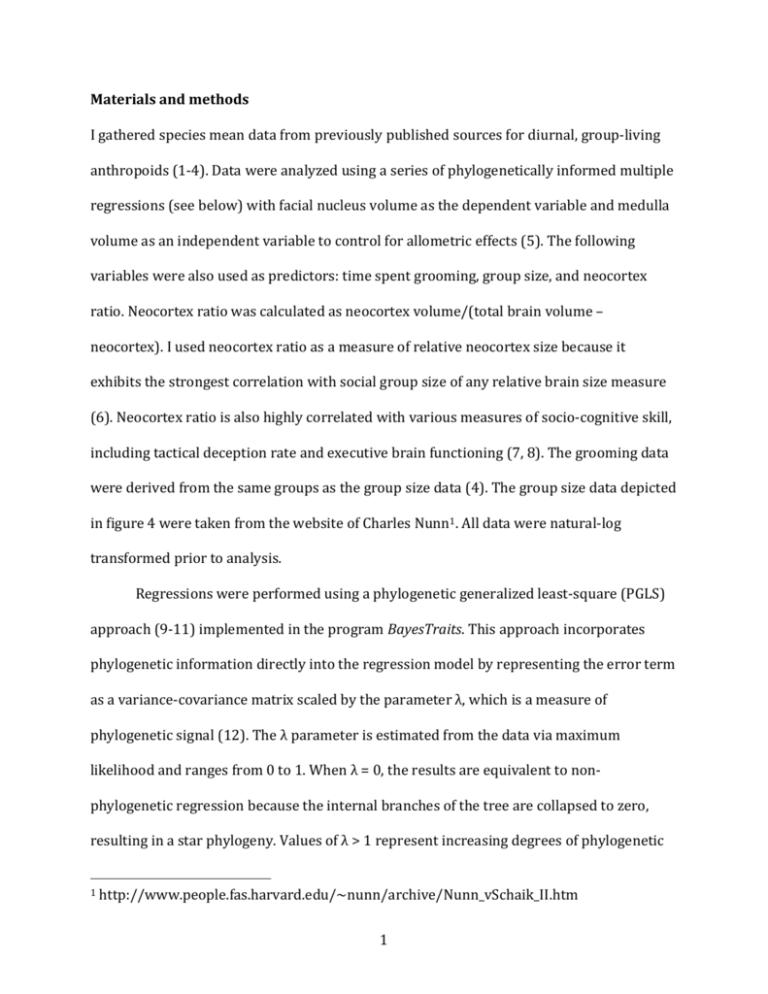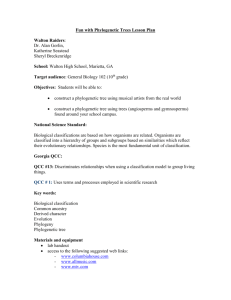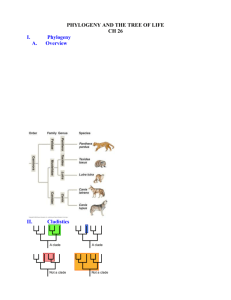Materials and methods I gathered species mean data from p
advertisement

Materials and methods I gathered species mean data from previously published sources for diurnal, group-living anthropoids (1-4). Data were analyzed using a series of phylogenetically informed multiple regressions (see below) with facial nucleus volume as the dependent variable and medulla volume as an independent variable to control for allometric effects (5). The following variables were also used as predictors: time spent grooming, group size, and neocortex ratio. Neocortex ratio was calculated as neocortex volume/(total brain volume – neocortex). I used neocortex ratio as a measure of relative neocortex size because it exhibits the strongest correlation with social group size of any relative brain size measure (6). Neocortex ratio is also highly correlated with various measures of socio-cognitive skill, including tactical deception rate and executive brain functioning (7, 8). The grooming data were derived from the same groups as the group size data (4). The group size data depicted in figure 4 were taken from the website of Charles Nunn1. All data were natural-log transformed prior to analysis. Regressions were performed using a phylogenetic generalized least-square (PGLS) approach (9-11) implemented in the program BayesTraits. This approach incorporates phylogenetic information directly into the regression model by representing the error term as a variance-covariance matrix scaled by the parameter λ, which is a measure of phylogenetic signal (12). The λ parameter is estimated from the data via maximum likelihood and ranges from 0 to 1. When λ = 0, the results are equivalent to nonphylogenetic regression because the internal branches of the tree are collapsed to zero, resulting in a star phylogeny. Values of λ > 1 represent increasing degrees of phylogenetic 1 http://www.people.fas.harvard.edu/~nunn/archive/Nunn_vSchaik_II.htm 1 dependence among the regression residuals, with λ = 1 indicating no transformation of the branch lengths were used because the error term is perfectly dependent on phylogeny. To take into account phylogenetic uncertainty, I downloaded a sample 100 chronometric trees from the 10kTrees website, which provides access to a Bayesian posterior probability distribution of primate phylogenies (13). I ran each analysis across the entire tree block so that the results would not be dependent on any one tree or set of branch lengths. The statistical significance of regression coefficients was assessed with reference to the conventional p-value thresholds. The λ parameter was estimated to be zero in all regressions, suggesting that the degree of phylogenetic dependence among regression residuals was negligible for the data and taxa used in this study. For this reason ordinary least-squares (OLS) residuals are plotted in figures 2-4. Moreover, the regression results were identical for all 100 trees downloaded from 10kTrees, due to the absence of residual phylogenetic signal. References 1. 2. 3. 4. 5. Stephan H, Frahm H, Baron G. New and revised data on volumes of brain structures in insectivores and primates. Folia Primatologica. 1981;35(1):1-29. Frahm HD, Stephan H, Baron G. Comparison of brain structure volumes in Insectivora and Primates. 5. Area striata (AS). Journal Fur Hirnforschung. 1984;25(5):537-57. de Sousa AA, Sherwood CC, Mohlberg H, Amunts K, Schleicher A, MacLeod CE, et al. Hominoid visual brain structure volumes and the position of the lunate sulcus. Journal of Human Evolution. 2010;58(4):281-92. Lehmann J, Korstjens AH, Dunbar RIM. Group size, grooming and social cohesion in primates. Animal Behaviour. 2007;74:1617-29. Sherwood CC, Hof PR, Holloway RL, Semendeferi K, Gannon PJ, Frahm HD, et al. Evolution of the brainstem orofacial motor system in primates: a comparative study of trigeminal, facial, and hypoglossal nuclei. Journal of Human Evolution. 2005;48(1):45-84. 2 6. 7. 8. 9. 10. 11. 12. 13. Dunbar RIM. The social brain hypothesis. Evolutionary Anthropology. 1998;6(5):178-90. Byrne RW, Corp N. Neocortex size predicts deception rate in primates. Proceedings of the Royal Society of London Series B-Biological Sciences. 2004;271(1549):16939. Shultz S, Dunbar RIM. Species Differences in Executive Function Correlate With Hippocampus Volume and Neocortex Ratio Across Nonhuman Primates. Journal of Comparative Psychology. 2010;124(3):252-60. Martins EP, Hansen TF. Phylogenies and the comparative method: A general approach to incorporating phylogenetic information into the analysis of interspecific data. American Naturalist. 1997;149(4):646-67. Pagel M. Inferring the historical patterns of biological evolution. Nature. 1999;401(6756):877-84. Garland T, Ives AR. Using the past to predict the present: Confidence intervals for regression equations in phylogenetic comparative methods. American Naturalist. 2000;155(3):346-64. Freckleton RP, Harvey PH, Pagel M. Phylogenetic analysis and comparative data: A test and review of evidence. American Naturalist. 2002;160(6):712-26. Arnold C, Matthews LJ, Nunn CL. The 10k Trees Website: A New Online Resource for Primate Phylogeny. Evolutionary Anthropology. 2010;19(3):114-8. 3







